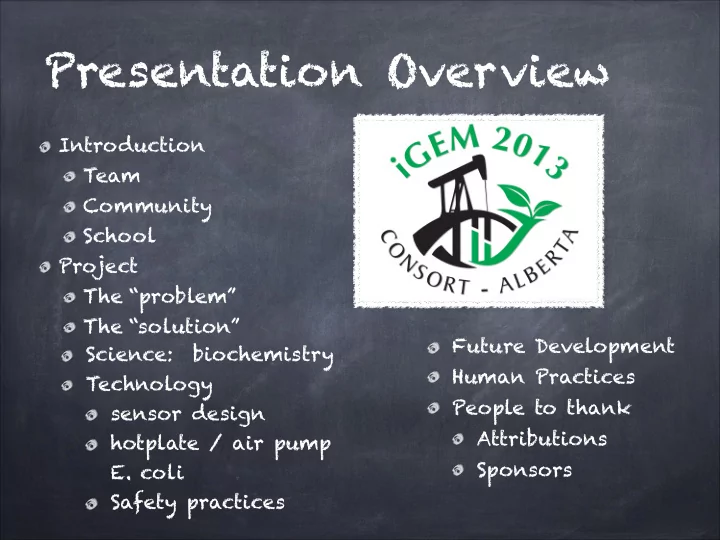

Presentation Overview Introduction Team Community School Project The “problem” The “solution” Future Development Science: biochemistry Human Practices Technology People to thank sensor design Attributions hotplate / air pump Sponsors E. coli Safety practices
Consort School IGEM 2013 Presentation
(Sage) www.worldatlas.com
Consort, Alberta Population: roughly 700. Approximately 3 1/2 hours southeast of Edmonton, 4 hours northeast of Calgary, and 3 hours west of Saskatoon. GoogleMaps (Sage)
Our Community (Sage)
We might live in the middle of nowhere, but we enjoy a ruggedly beautiful landscape as a result. www.neutralhills.ca (Sage)
Lease Land - in the middle of a farmer's field. (Sage)
Our school Kindergarten to grade 12 student population of about 230 most are farm kids, bused in from a surrounding area of roughly 2500 square kilometers. (Sage)
Our Team (Sage)
The Problem Special Areas #4 Farming Ranching Oil industry (Kris)
*lease land *a pump jack is active in the middle of a newly planted crop. (Kris)
Everything we grow ends up here (Kris)
The Solution Hydrocarbon detector To be used in agriculture To be used by the oil industry (Kris)
Our Challenge Instead of being an obstacle, our remoteness turned out to be one of the most exciting challenges of our project. (Kris)
The Solution Technology Our incubator (food dehydrator) (chick hatchery) Fridge and microwave Our shaker table (Kris)
Our Project Science development of ECOS E. coli (Spencer)
E.coli Plasmid Design Components for our first plasmid DNA sequence (Total size is 5708Bp) 1) BBa_1723021 (2282Bp) (Created by iGEM07_Glasgow) 2) pSB1AK8 (3426Bp) (Spencer)
Components for our second plasmid DNA sequence (Total size is 4610Bp): 1) BBa_1723030 (320Bp) 2) BBa B0030 (158Bp) 3) BBa_E0040 (158Bp) 4) BBa_B0015 (129BP) 5) pSB1AK8 (3426BP) (Spencer)
Application / Technology Components for the application of our project: 1) Power Source 2) Heater 3) Pump 4) E.coli box (sealed) 5) UV Flashlight 6) Tubing 7) Funnel 8) A wavelength detector (Spencer)
The reason why this is useful is because more harmful aromatic hydrocarbons are going to be found with xylene but will be more prominent than xylene Examples: benzene and toluene Benzene “is generally considered that the only absolutely safe concentration for benzene is zero. ” - American Petroleum Institute (API) (Spencer)
Advantages: - cost effective - ease of use - fast: samples don't have to be sent away for analysis - rapid testing = more accurate results - oil companies can have tests done to reduce their liability for workers - doesn't take a lot of training - farmers can test for hydrocarbons quickly and easily for their personal safety and to ensure the quality of their crops and cattle - local solution, world-wide applications (Josh)
Future Development Next steps: Accurate measurement of level of hydrocarbons, by quantifying the amount of fluorescence as derived from a sample. standardize the concentration of E.coli in our solution, size of our sample, the flow rate of our pump, and the length of time for testing, continue to develop our E.coli working prototype (Josh)
Safety Protocols Multi-purpose room fish students meeting room lab work (Mark)
Risk: ethidium bromide gloves, goggles, lab coats waste material practices: autoclave, or bleach before disposal kill switch 1/2 life of two hours MSDS - Materials Safety Data Sheet (Mark)
Human Practices Communicating the Benefits to our community Community reception (Beckie)
parent meeting local oil companies local businesses family ranches community meeting classroom presentations (Taylor)
The Consort iGEM Team would like to thank everyone that contributed to our team and project: The following iGem teams: Lethbridge, Attributions Calgary, and Edmonton for advising us as well as lending us their time. The following organizations: Neutral Hills Ag Society, Prairie Land Regional Division, Three Star Oilfield Services, Compass Signs and Alberta Innovates Technology Futures. As well as the following people: Wendy Murphy, Mrs. Bourassa, Mark and Holly Riopel, Dr. Ron Watson, Ms. Strobel, Jennifer Gallaway and the Consort ECS, Mrs. Davies, and Mr. Bourassa. (Taylor)
Our Wonderful Sponsors (Beckie)
Thank you!
Questions :) :)
Future Development Next steps: How do we measure the concentration of the hydrocarbons, using the intensity of the fluorescence as the gauge? We must find the correlation between the amount of xylene detected and the fluorescence of the E.coli. This will allow us to identify to the amount of xylene and in extension benzene and benzene derivatives. This is a indicator of how many dangerous compounds are in the environment at the time. Furthermore, we need to standardize the concentration of E.coli in our solution, size of our sample, the flow rate of our pump, and the length of time for testing. (Josh)
Recommend
More recommend